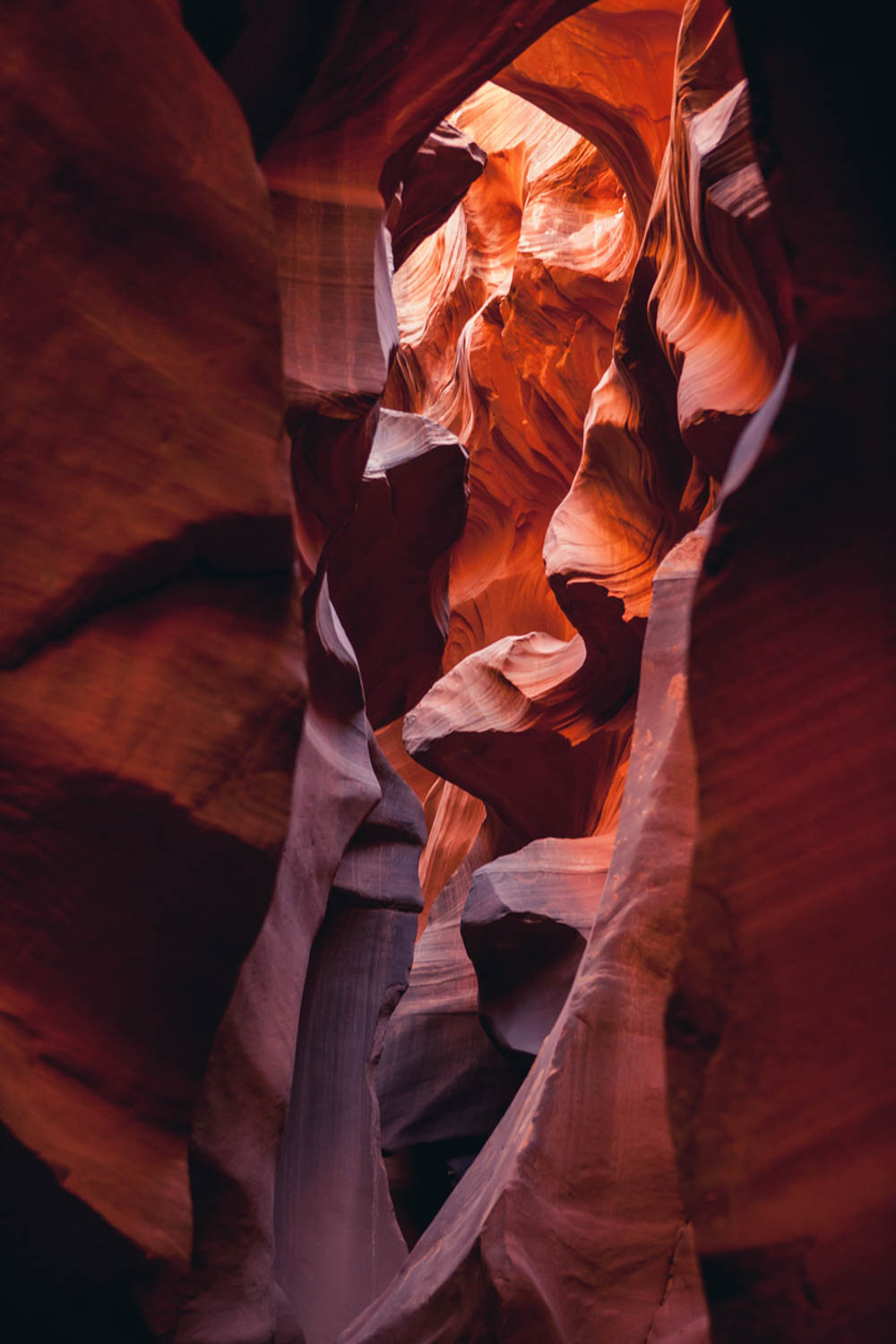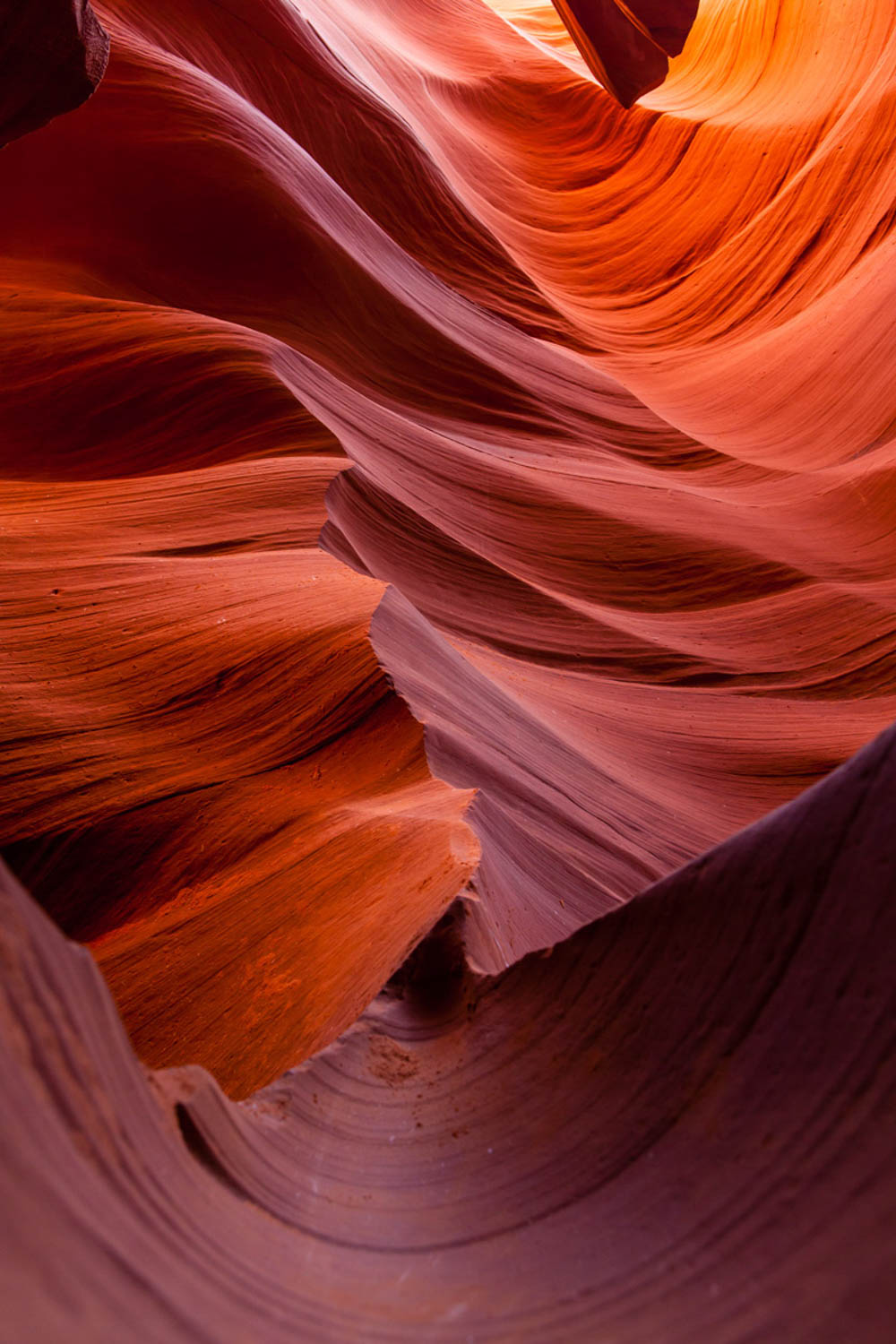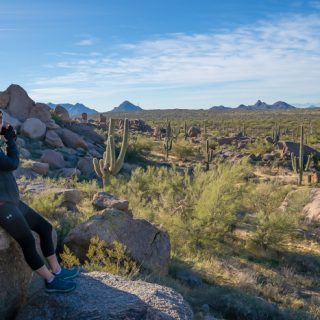Arizona’s unique and famously beautiful Antelope Canyon is actually made up of two sections—Lower Antelope Canyon and Upper Antelope Canyon. Even if you didn’t know there were two parts to it, chances are you’re familiar with its iconic colorful slot canyon walls.
Upper Antelope Canyon may be more well-known due to the shafts of light that stream down into the slot canyons during midday, but for the best experience overall you may want to visit Lower Antelope Canyon instead.
This post was originally written by a friend of mine who has since retired his travel blog. He has allowed me to make it mine and republish it here on MWL.

Why visit Lower Antelope Canyon?
Let me begin by saying that if you’re enthusiastic about photography and have time for both tours, you should definitely consider visiting both Upper and Lower Antelope Canyon. They have different looks and you’ll get a full experience seeing both versions.
However, if you only have time for one, Lower Antelope Canyon is better for a few reasons:
It’s one-way
The biggest part of its appeal for me is that foot traffic only goes one way. You enter from one side and exit from the other. This means you won’t have to contend with the crowded return traffic while making your way through the slot canyon.
It’s less crowded
Speaking of crowds, Lower Antelope Canyon is far less crowded than the much more famous Upper Canyon. This isn’t just because of the one-way traffic, however. There are actually fewer companies that visit Lower Antelope Canyon and they travel in smaller groups as well. That means even if you’re in sold out tour groups like I was, it’s still a fairly intimate experience.
It’s cheaper
It’s also cheaper to visit Lower Antelope Canyon than it is the Upper canyon. And who doesn’t like to save money? The tours through Lower Antelope Canyon cost $50 per person for the regular tour, whereas the most basic tours for the Upper canyon are almost twice that.
Read also: What to Pack for Arizona in the Winter (& What I Wish I’d Brought)
Read on to learn more about the lower canyon to see if it’s a better fit for you!

How to get to Lower Antelope Canyon
Both Upper and Lower Antelope Canyons (part of the Lake Powell Navajo Tribal Park) are located about 10 minutes east of Page, Arizona, near the Utah border. Lower Antelope Canyon itself is located on Indian Route 222, just west of Page off Highway 98.
This is a perfect stop during a road trip of Utah’s National Parks and made a great conclusion to my own trip.
Looking to spend more time in Arizona? Check out my guide to spending 4 days in Scottsdale and add this vibrant city to your itinerary!

Lower Antelope Canyon tours
There are only two companies that lead tours of Lower Antelope Canyon: Ken’s and Dixie’s. Both are well-reviewed but Ken’s is the one I took. Here’s a little bit more information on each:
Ken’s Tours
- Maximum tour group size: 8 people
- Tour length: 1 hour 15 minutes
- Total price for adults: $69.66 per person ($55 tour + $8 Navajo Park Permit + 6% Navajo sales tax + 6% processing fee. Child tour price is also $55.)
- Does have a waitlist if your preferred date/time is already fully booked.
Dixie’s Lower Antelope Canyon Tours
- Maximum tour group size: 7 people
- Tour length: 1-1.5 hours
- Total price for adults: $71.08 per person ($55 tour + $8 Navajo Nation Permit + 6% Navajo sales tax + 2.2% Processing fee + 6% “online convenience” fee. Child tour price is $35.)
- Does not have a waitlist.

Lower Antelope Canyon photography tours
Antelope Canyon tour operators used to offer photography tours in addition to the general sightseeing tours. However, Navajo Nation significantly cut back on the allowance of those due to the frequent bottlenecks inside the canyons caused by the multitude of tripods and all the time photographers spent setting up shots, etc.
You can still find photography tours for the Upper canyon, but both Lower Antelope Canyon tour operators have done away with them.
Tours are mandatory
Because Lower Antelope Canyon is a sacred site protected by Navajo Nation Parks and Recreation, visiting the canyon on your own is strictly prohibited. If you want to visit these sites you can only do so with a trained tour guide, and only the two companies above have authorization to run tours to Lower Antelope Canyon. (If you want to visit the Upper canyon though, you have a wider selection of tour providers to choose from.)
It has been this way since 1997 when the Navajo Tribe officially declared it a Navajo Tribal Park, and the same year a flash flood through the canyons tragically killed 11 hikers. Now, to ensure visitor safety (and to prevent vandalism to this sacred site), all hikers must be accompanied through these canyons with a trained and experienced guide. This isn’t your typical walk in the (National) park after all.
Read also: What You Need to Know for Your Sunrise Hot Air Balloon Ride in Arizona

Lower Antelope Canyon: What to expect
Both Ken’s and Dixie’s canyon tours recommend arriving to the site about 30-45 minutes early for check-in. Both have ample free parking near the canyons.
Once it’s time for your tour to depart, instead of loading into a truck like you would on the Upper Canyon tours, you’ll meet your guide and take a short 10-minute walk to the entrance of Lower Antelope Canyon.
From there, you’ll descend a series of steep metal ladders/stairs down into the canyon entryway. These ladders are securely bolted into the canyon walls and include safety handrails as well.
Once you’ve entered Lower Antelope Canyon, you’ll follow your guide through the winding slot canyons. The canyon runs about 3/4 of a mile long and the tour takes its time going through it. Our guide was quick to point out the various shapes in the rocks and had some good suggestions for creative photo angles as well.
Even though this was not a photography-specific tour, the guides were incredibly helpful with photography advice, even suggesting certain filters for the iPhone users in our group. There were a few open areas where our guide would stop and offer to take group photos as well. Overall it was a great experience and our guide did a fantastic job; he was obviously enthusiastic about what he did and his excitement was contagious.

How to photograph Lower Antelope Canyon
While Ken’s used to operate special photography tours, they don’t any longer. Regardless, I took the regular tour which actually prohibits the use of tripods altogether. It wasn’t too much of an issue with my camera, but I did have to crank the ISO settings.
Most of my shots were around ISO 1200-2400 and wide open at f/ 2.8. Although it was a shorter tour, I still found it to be enough time to get the shots I wanted. I can definitely see the appeal of the longer photography tours offered in the Upper canyon though, where you can really take your time and travel with a smaller group.
It’s a bit dark 120 feet down in the slot canyons, so it helps to have a camera with decent low light ability. You’ll have to pay attention to your settings if you want the best results, but even the visitors with nothing but a smartphone came away with great shots.
Lower Antelope Canyon photography tips:
But should you go in there with a more advanced camera, here are some of my best tips for photographing Lower Antelope Canyon:
ISO Settings
I started out at ISO 640 and rode this setting the most, sometimes all the way up to 3200. Most of my photos were taken at 1200.
Aperture
I was wide open at f/2.8 the whole time and was happy with the results. The shallow depth of field gives the slot canyons a mysterious look. Unfortunately, if you want a deep image that captures everything in focus from front to back, you would need to use a tripod and shoot at f/8 or higher.

Shutter Speed
Be sure to keep an eye on your shutter speed when you’re shooting handheld and compensate with your ISO as needed to keep motion blur out of your shots.
Exposure
Try not to overexpose your shots, the colors pop a bit more when they’re slightly darker. It should go without saying that you should be shooting RAW to give yourself flexibility to adjust in post editing.
Framing
If possible, try not to capture the sky in your shots (sometimes you can’t avoid it). With the difference in light it will just be blown out and take away from some of the mystery of the canyon walls. Try to look for abstract framing opportunities as well. Sometimes a small area can look super cool when photographed at the right angle.
Go Wide
You can leave the telephoto lens at home for this one; Lower Antelope Canyon looks best when captured with a wide lens. The canyon walls are VERY narrow in some places and wider lenses do a great job of capturing the scale of them.
Capturing Colors
It will be helpful to up your in-camera saturation a bit, but don’t go too overboard if your shots will have people in them. The canyon walls do a great job of showing off the colors on their own. Don’t forget to set your white balance to daylight (or shade if you want to really bring out the reds); auto white balance will suck the color out of the red and purple walls.
In the end, it’s nearly impossible to visit Lower Antelope Canyon without getting good shots. It’s such a magnificent and scenic area that it just naturally pops in photos. If you have time, check out Upper Antelope Canyon as well and try to photograph its famous rays of light, but rest assured that you’ll get the full experience down here in the lower canyon.

What to pack for Lower Antelope Canyon
Lower Antelope Canyon has pretty strict rules about what you can and can’t bring on the canyon tours, but there are a few specific things you’ll need to consider. Here are a few must-haves for your canyon tour:
- Bottle of water – You’re in the Southwest; stay hydrated! Opt for a refillable water bottle of course.
- Sunscreen – yes, even in the winter
- A decent camera
- Bandana, hat, sunglasses, or something similar to protect your face and eyes from the sand
- Cash for tipping the guide if you feel so inclined
What shoes to wear for your canyon tour
Because this is technically a hike, proper hiking shoes are recommended by both tour groups. My husband and I both wear Oboz hiking boots on anything even remotely resembling a hike and I highly recommend them. Check them out for yourself here:
Oboz Bridger for women on Amazon and Zappos
Oboz Tamarack for men on Amazon and Zappos
If hiking boots aren’t your preference, definitely stick with solid, comfortable shoes made for activity. No open-toed shoes, sandals, or anything with a heel are permitted in Lower Antelope Canyon. I mean, be smart about it.

What NOT to bring for your canyon tour
As strict as they are about what you can bring, they are wayyy stricter about what you can’t. Don’t wait until you get there to figure this out – here’s a list of things you cannot bring with you on a Lower Antelope canyon tour:
- Purses, backpacks, fanny packs, hydration packs, camera bags, or any other kind of bag. Just no bags at all. If you can’t fit it in your pocket, carry it around your neck, or hold it in your hand (like the water bottle), leave it behind.
- Tripods, monopods, or selfie sticks – regular ol’ handheld cameras only
- GoPros, drones, or other video cameras – filming is not allowed inside the canyon
- Food
- Trash
- Umbrellas – If there’s bad weather, your tour will be canceled anyway. For sun, just wear a hat and protective clothing.
- A full bladder (i.e., there are no bathrooms in the canyons)
- Baby carrier (children 2 and younger have to be strapped to your body)
- Pets/animals – even if they can climb up and down ladders, which would be impressive
- Your loved one’s ashes – This is a sacred Navajo site and they kindly demand that you refrain from scattering your loved ones’ ashes in the canyons. How often must this be attempted for this even to be a common canyon no-no?
Read Also: How to Choose the Perfect Hotel for Your Trip, Every Time
Where to stay near Lower Antelope Canyon
The Lower Antelope Canyon tours themselves aren’t incredibly time-consuming, but you will need to arrive with plenty of time to spare just in case. Plus, you may want to opt for one of the combination tours that cover more of the area’s offerings.
If that’s the case, staying overnight nearby is not a bad idea. Here are a few accommodation options for your visit to Lower Antelope Canyon:
Best Western View of Lake Powell
Well, the name says it all I guess! This well-reviewed hotel is close to the Antelope Canyon tours, Horseshoe Bend, and, you guessed it, offers views of Lake Powell from their outdoor terraces as well.
They offer free WiFi, free parking, free hot breakfast buffet, and 24-hour reception. Lower Antelope Canyon is just a 10-minute drive away.
Hampton Inn & Suites Page
Also just 10 minutes away is the Hampton Inn & Suites in Page, AZ. You’ll also enjoy free WiFi, free parking, and a 24-hour front desk here, as well as a 24-hour shop with snacks, drinks, and various travel necessities.
Past guests absolutely love this property and rated it highly for cleanliness, the quality of the breakfast, and the size of the rooms (and much more.)
Country Inn & Suites by Radisson
This hotel has an “Awesome” 9/10 rating by past guests and is just a 9-minute drive to Lower Antelope Canyon. They too offer free WiFi and free parking, as well as a bar and lounge, mountain views, and laundry facilities.

Important things to remember for your visit
Knowing what to bring (and what not to), how to set up your shots, and which tours are available is just half the battle. Having a great time on your Lower Antelope Canyon tour is the other half. To accomplish that, here are a few things to keep in mind for your trip:
Not for the claustrophobic
Besides climbing down 120 feet into the gut of Arizona, the canyon is incredibly narrow, with low-hanging rock formations, a winding pathway, and virtually no immediate escape route. I’m just saying, if you get uneasy in tight, confined spaces, maybe think a bit more on this.
So much sand
There’s going to be a lot of sand that will get in your face, your hair, your ears, your camera equipment, and everywhere else. It’s recommended to bring a hat, sunglasses, a buff, or whatever else you prefer to help keep some of the sand out of your face. (Face masks are required anyway because of our current situation, so that will help at least! Yay.)
For this reason, tour operators also recommend that if you wear contact lenses, you might want to consider removing them for your tour and opting for glasses instead. (Speaking from experience, I say opt out of both of them for good and get yourself some LASIK already! If you’ve been waiting for a sign, this is it. Best money I ever spent.)
Also, when not using your camera, be sure to keep the lens cap on and try to keep it covered; a plastic bag or shower cap works nicely. Also, I wouldn’t recommend changing the lens while you’re down there.
Luckily, my Olympus OM-D E-M5 mirrorless camera is fully dust, sand, and idiot-proof. But if yours isn’t, pay extra attention here. Also, spring for a camera dust blower to get the sand out of all the crevices.
Know the correct time
Lower Antelope Canyon and its tour operators follow Arizona Standard Time meaning they do not respect Daylight Saving Time. So, in the summer, they are one hour behind Utah, New Mexico, and the Navajo Reservation. Being that they are very close to the Utah border, this may confuse your time keeping and tour booking.
When you book the tour, keep this in mind when figuring out what time you’ll be able to get there. And on the day of your tour, keep this in mind when waking up and/or traveling across time zones to get there.
More info for your Lower Antelope Canyon trip
- Staying overnight? Find great places to stay here.
- Exploring more? Pick up an Arizona + Grand Canyon guidebook
- Want more fun activities? Check out these awesome tours in Arizona.
- Need some wheels? Check out rental car options here.
Will you be sticking to Lower Antelope Canyon or visiting the Upper canyon as well?
Let me know in the comments below!
Save this info, pin this image:





